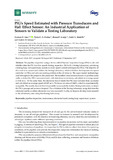| dc.description.resumo | The pipeline inspection using a device called Pipeline Inspection Gauge (PIG) is safe and
reliable when the PIG is at low speeds during inspection. We built a Testing Laboratory, containing
a testing loop and supervisory system to study speed control techniques for PIGs. The objective of
this work is to present and validate the Testing Laboratory, which will allow development of a speed
controller for PIGs and solve an existing problem in the oil industry. The experimental methodology
used throughout the project is also presented. We installed pressure transducers on pipeline outer
walls to detect the PIG’s movement and, with data from supervisory, calculated an average speed
of 0.43 m/s. At the same time, the electronic board inside the PIG received data from odometer
and calculated an average speed of 0.45 m/s. We found an error of 4.44%, which is experimentally
acceptable. The results showed that it is possible to successfully build a Testing Laboratory to detect
the PIG’s passage and estimate its speed. The validation of the Testing Laboratory using data from the
odometer and its auxiliary electronic was very successful. Lastly, we hope to develop more research
in the oil industry area using this Testing Laboratory. | pt_BR |




